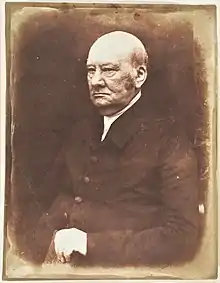Jabez Bunting
Jabez Bunting (13 May 1779 – 16 June 1858) was an English Methodist leader and the most prominent Methodist after John Wesley's death in 1791.
Jabez Bunting | |
|---|---|
 Dr Jabez Bunting by Hill & Adamson | |
| President of the Methodist Conference | |
| In office 1820–1821 | |
| Preceded by | Jonathan Crowther |
| Succeeded by | George Marsden |
| In office 1828–1829 | |
| Preceded by | John Stephens |
| Succeeded by | James Townley |
| In office 1836–1837 | |
| Preceded by | Richard Reece |
| Succeeded by | Edmund Grindrod |
| In office 1844–1845 | |
| Preceded by | John Scott |
| Succeeded by | Jacob Stanley |
| Personal details | |
| Born | 13 May 1779 Manchester |
| Died | 16 June 1858 (aged 79) |
| Occupation | Methodist preacher |
Bunting began as a revivalist but became dedicated to church order and discipline. He was a popular preacher in numerous cities. He held numerous senior positions as administrator and watched budgets closely. He and his allies centralised power by making the conference the final arbiter of Methodism, and giving it the power to reassign preachers and select district superintendents. He was particularly zealous in the cause of foreign missions. Politically, he was conservative, as were most Methodist leaders of the time.
Career
Born of humble parentage at Manchester, he was educated at Manchester Grammar School. He had been converted at the age of twelve under the ministry of the Wesleyan Joseph Benson, and, at the age of nineteen, began to preach among the revivalists. He was still a practising revivalist as late as 1802. At Macclesfield, he saw revivals leading to dissension and division, and his views changed fundamentally. From this time onwards Bunting was a exponent of church order and discipline, and an implacable opponent of revivalism. He was received into full Connexion (i.e., becoming an ordained minister) in 1803. He continued to minister for upwards of 57 years in Manchester, Sheffield, Leeds, Liverpool, London and elsewhere.
In 1835, he was appointed president of the first Wesleyan theological college (at Hoxton), and in this position he succeeded in materially raising the standard of education among Wesleyan ministers. He was four times chosen to be President of the Conference (the ruling body of the Wesleyan Methodist Church), in 1820, 1828, 1836 and 1844, was repeatedly secretary of the Legal Hundred, and for eighteen years was secretary to the Wesleyan Missionary Society. Under him Methodism ceased to be tied to the established Church of England and became wholly separate. He favoured the extension of lay power in committees, and was particularly zealous in the cause of foreign missions. Under Bunting's presidency in 1820 the Resolutions on Pastoral Work or Liverpool Minutes were adopted by the Wesleyan Methodist Conference in Liverpool,[1] setting out the working principles by which the Methodist leaders present at the conference sought "to cultivate more fully the spirit of Christian pastors". They were revised by conference in 1885.[2]
Methodist researcher Andrew Stobart[3] notes that the resolutions were adopted at a time when the recently established Wesleyan Methodist Church was struggling to maintain membership numbers in its early years: the movement had recorded a net loss of 4,688 members during the previous year.[1]
Politically, Bunting was conservative: for example, as President of the Conference, he supported the transportation of the Tolpuddle martyrs[4] despite the fact that they were closely linked to Methodism, their leaders being local preachers.
In 1849, the Wesleyan Reform movement broke away from the Wesleyan Church following the expulsion of James Everett, William Griffith and Samuel Dunn, critics of Bunting's leadership, from the Wesleyan Church's Manchester Conference.[5]
Bunting was a popular preacher and an effective platform speaker; in 1818 he was given the degree of M.A. by the University of Aberdeen, and in 1834 that of D.D. by Wesleyan University of Middletown, Connecticut, United States.
His eldest son, William Maclardie Bunting (1805–1866), was also a distinguished Wesleyan minister; and his grandson Sir Percy William Bunting (1836–1911), son of T. P. Bunting, became prominent as a liberal nonconformist and editor of the Contemporary Review.
He died in 1858 and was interred in Wesley's Chapel, London.
References
- Stobart, A., Editorial in Holiness: the Journal of Wesley House Cambridge, Volume 3 (2017) Issue 1
- Liverpool Minutes 1820, ‘Resolutions on Pastoral Work’, I, found in The Constitutional Practice and Discipline of the Methodist Church, Volume 1, Peterborough: Methodist Publishing House, 1988
- Wesley House Cambridge, Andrew Stobart. Retrieved 2 June 2019
- Kent, J. (1977), Methodism and social change in Britain. In T. Runyon (Ed.), Sanctification and liberation, pp. 83–101. Nashville TN: Abingdon Press.
- David Barton, "By Schisms Rent Usunder": The Wesleyan Reform Movement in Derbyshire, Proceedings of the Wesley Historical Society, May 1999
![]() This article incorporates text from a publication now in the public domain: Chisholm, Hugh, ed. (1911). "Bunting, Jabez". Encyclopædia Britannica (11th ed.). Cambridge University Press.
This article incorporates text from a publication now in the public domain: Chisholm, Hugh, ed. (1911). "Bunting, Jabez". Encyclopædia Britannica (11th ed.). Cambridge University Press.
Further reading
- Karl, J. H. S. "The Interpretation of Jabez Bunting", Proceedings of the Wesley Historical Society (1958) 31#6 pp 125–132' (1958) 31#7 pp 150–154 and (1959) 32#1 pp 13–17.
- Ward, W. R. "Bunting, Jabez (1779–1858)", Oxford Dictionary of National Biography, Oxford University Press, 2004; online edn, Oct 2007 accessed 1 Oct 2016 doi:10.1093/ref:odnb/3947
Primary sources
- Hayes, Alan, and David Gowland, eds. Scottish Methodism in the Early Victorian period: The Scottish Correspondence of the Rev. Jabez Bunting, 1800–1857 (1981).